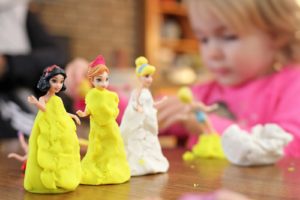How can playdough develop my child’s play and language skills?
Our North Brisbane Paediatric Speech Pathologists are talking playdough this week and how its use can develop play and language skills.

Playdough. It is not just a squishy substance that kids mush together and occasionally eat. It actually has a lot of important uses to aid children’s play and language development.
Play enables children to learn life skills while having fun. It teaches them problem solving and creativity, while developing communication and confidence.
Playdough and other types of modelling clay especially helps children to be creative, problem solve and create worlds. It has many uses and develops many aspects of play such as;
Fine motor skills
Playdough is used to help develop strength and manipulation through the fingers, and is a fun way to learn letter formation and shape recognition. When children are learning to write their names, they need to be able to identify the basic shapes of the letters and then copy them.
Team work
In a group setting; working together to make a complex playdough construction can foster teamwork and a supportive environment for children. By working together to achieve a single goal; this fosters the team environment and teaches children to share, take turns and work as a team.
Creativity and flexible thinking
Playdough encourages creativity and flexible thinking in children. They use their creativity to turn the doh into fantasy castles, race cars, a one-eyed octopus; a rocketship to the moon and more. More often than not; children will need to use their creative thinking about how to shape the playdough to achieve this goal. Children learn to use flexible thinking to achieve their creative visions.
Problem Solving
Similar to the flexible thinking; playdough helps children to problem solve and change ideas to achieve the end goal. Children must problem solve to determine what how to make it; how to fix it; how to make it better and what shapes to make?
Persistence
How many times does a playdough sculpture break or squish before it reaches completion? How many times do they accidentally fall on the floor or do siblings mash the playdough before its done? Answer: A LOT! Kids learn to persist and persevere to keep building that playdough sculpture and use the aforementioned problem solving and flexible thinking to make it bigger, better and more long lasting.
Planning
Do you often look at a playdough design your children are making and think “What on earth is that?” Well, chances are they know exactly what it is and what every little part is and can tell you all about it. Children plan what they are making and can tell you why every little bit is on there. Playdough teaches children to plan and think ahead about what they are making and what shapes they need to make to achieve the goal.

Communication skills
Lastly and importantly, playdough develops and supports communication skills. During playdough play, children will start to incorporate narrative. They will build stories and worlds around their creations and it will take on a life of their own. Narrative development has wide impacts on social interaction, reading comprehension and academic success.
Narratives or stories refer to a recount or creation of events and can be written or verbal. They help us understand and problem solve events that have occurred. Narrative allows us to think about what happened before and predict what might happen after an event. They guide and shape the actions we take and is an important social skill we use to interact with other people. Narrative helps us to defend our choices, explain ourselves, to logically think about our actions and educate ourselves and others in the process.
Children playing with playdough create their own worlds; their own stories and will begin to think about what happened first, what might happen after and through group interaction will start to think about the impact the actions have on other people. Play is a safe place to play through situations and events that may be scary; and see what happens. For example, if a child is scared to go to the dentist; making a dentist scene with playdough and playing through an interaction can help them to see what might happen and how it might impact them.
Generally, narrative begins to develop around age 3 and by age 7 to 8; children typically have developed narrative skills such that all important story grammar elements are included in a logical story.
If you have any concerns about your child’s play or narrative skills; please do not hesitate to contact our lovely client care team on 3265 4495 and ask about our Occupational Therapy and Speech Pathology services today.
